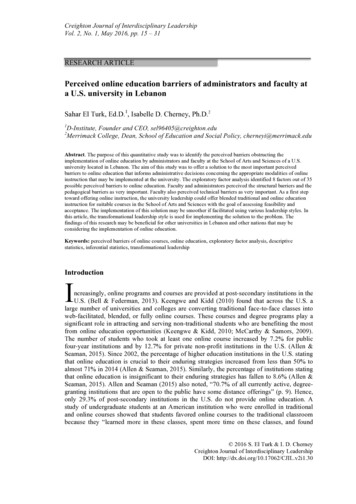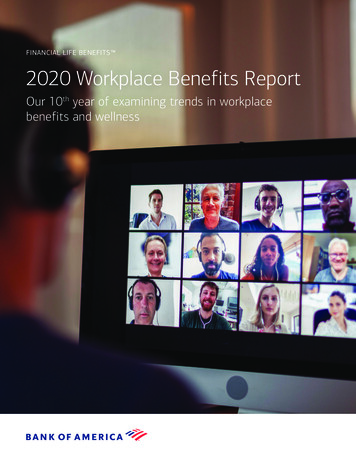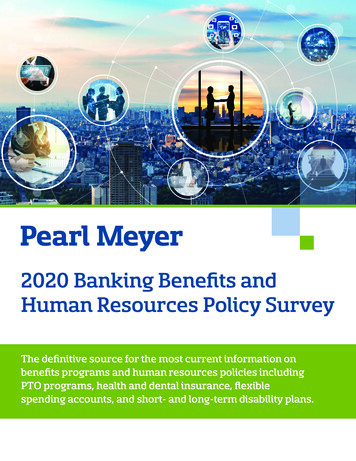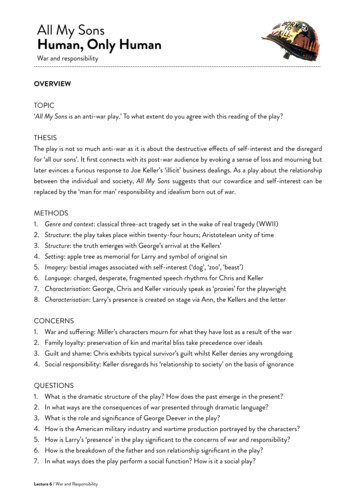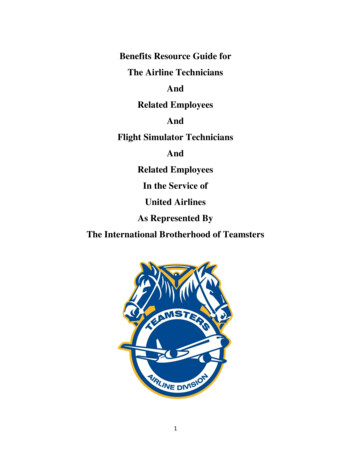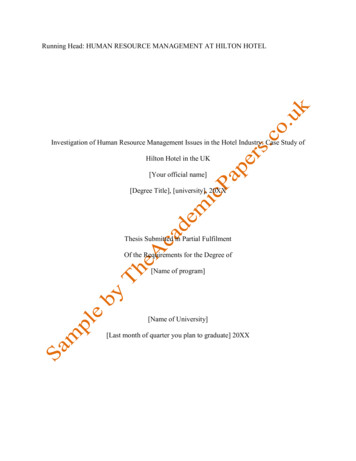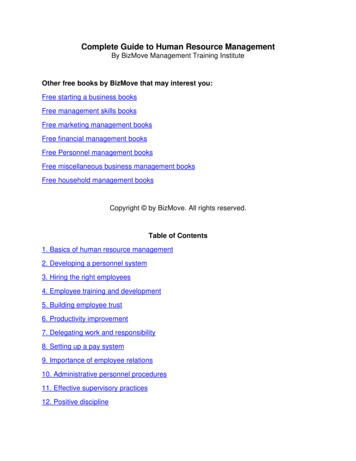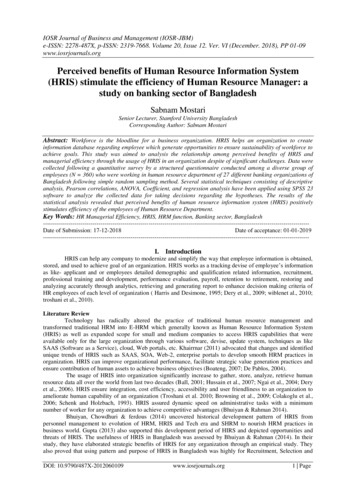
Transcription
IOSR Journal of Business and Management (IOSR-JBM)e-ISSN: 2278-487X, p-ISSN: 2319-7668. Volume 20, Issue 12. Ver. VI (December. 2018), PP 01-09www.iosrjournals.orgPerceived benefits of Human Resource Information System(HRIS) stimulate the efficiency of Human Resource Manager: astudy on banking sector of BangladeshSabnam MostariSenior Lecturer, Stamford University BangladeshCorresponding Author: Sabnam MostariAbstract: Workforce is the bloodline for a business organization. HRIS helps an organization to createinformation database regarding employee which generate opportunities to ensure sustainability of workforce toachieve goals. This study was aimed to analysis the relationship among perceived benefits of HRIS andmanagerial efficiency through the usage of HRIS in an organization despite of significant challenges. Data werecollected following a quantitative survey by a structured questionnaire conducted among a diverse group ofemployees (N 360) who were working in human resource department of 27 different banking organizations ofBangladesh following simple random sampling method. Several statistical techniques consisting of descriptiveanalysis, Pearson correlations, ANOVA, Coefficient, and regression analysis have been applied using SPSS 23software to analyze the collected data for taking decisions regarding the hypotheses. The results of thestatistical analysis revealed that perceived benefits of human resource information system (HRIS) positivelystimulates efficiency of the employees of Human Resource Department.Key Words: HR Managerial Efficiency, HRIS, HRM function, Banking sector, -------------------------------------------Date of Submission: 17-12-2018Date of acceptance: --------------------------------------------I. IntroductionHRIS can help any company to modernize and simplify the way that employee information is obtained,stored, and used to achieve goal of an organization. HRIS works as a tracking devise of employee’s informationas like- applicant and or employees detailed demographic and qualification related information, recruitment,professional training and development, performance evaluation, payroll, retention to retirement, restoring andanalyzing accurately through analytics, retrieving and generating report to enhance decision making criteria ofHR employees of each level of organization ( Harris and Desimone, 1995; Dery et al., 2009; wiblenet al., 2010;troshani et al., 2010).Literature ReviewTechnology has radically altered the practice of traditional human resource management andtransformed traditional HRM into E-HRM which generally known as Human Resource Information System(HRIS) as well as expanded scope for small and medium companies to access HRIS capabilities that wereavailable only for the large organization through various software, devise, update system, techniques as likeSAAS (Software as a Service), cloud, Web portals, etc. Khairrnar (2011) advocated that changes and identifiedunique trends of HRIS such as SAAS, SOA, Web-2, enterprise portals to develop smooth HRM practices inorganization. HRIS can improve organizational performance, facilitate strategic value generation practices andensure contribution of human assets to achieve business objectives (Boateng, 2007; De Pablos, 2004).The usage of HRIS into organization significantly increase to gather, store, analyze, retrieve humanresource data all over the world from last two decades (Ball, 2001; Hussain et al., 2007; Ngai et al., 2004; Deryet al., 2006). HRIS ensure integration, cost efficiency, accessibility and user friendliness to an organization toameliorate human capability of an organization (Troshani et al. 2010; Browning et al., 2009; Colakoglu et al.,2006; Schenk and Holzbach, 1993). HRIS assured dynamic speed on administrative tasks with a minimumnumber of worker for any organization to achieve competitive advantages (Bhuiyan & Rahman 2014).Bhuiyan, Chowdhuri & ferdous (2014) uncovered historical development pattern of HRIS frompersonnel management to evolution of HRM, HRIS and Tech era and SHRM to nourish HRM practices inbusiness world. Gupta (2013) also supported this development period of HIRS and depicted opportunities andthreats of HRIS. The usefulness of HRIS in Bangladesh was assessed by Bhuiyan & Rahman (2014). In theirstudy, they have elaborated strategic benefits of HRIS for any organization through an empirical study. Theyalso proved that using pattern and purpose of HRIS in Bangladesh was highly for Recruitment, Selection andDOI: 10.9790/487X-2012060109www.iosrjournals.org1 Page
Perceived benefits of Human Resource Information System (HRIS) stimulate the efficiency .performance appraisal purposes that was different than other countries which contradicted the findings ofKovach and Cathcart (1999) and Groe et al. (1999). They also stated most frequently used software fromvendors for both service and manufacturing industries. Such as- Abra Suite, Oracle, People Soft, Vantage etc.Shiri (2012) investigated that adoption of HRIS will enhance the productivity of an organization.Bhuiyan & Gani (2015) had demonstrated pivotal necessity of HRIS in Bangladesh by using principalComponent Analysis method on 1200 respondents from banking sector of Bangladesh. Khera & Gulati (2012)measured pertinent benefits of HRIS on the basis of information which collected from 127 respondents of ITsector of India and also discussed Role and Contribution of HRIS to enhance productivity of HR manager aswell as organization. In spite of pivotal benefits HRIS, many organizations couldn’t gain optimum developmentof HR department through this upgrade technology due to some obstacles as such- lack of managementcommitment, preferences of status quo, improper need assessment, lack of proper knowledge, lack of expertiseetc. (Bhuiyan & Rahman,2014; Ngai & Wat, 2004; Rahman Khan, A., Hasan, N., & Rubel, M. 2015 ). Rahman,Islam & Qi (2017) had conducted an exploratory Factor Analysis on 25 Garments of Bangladesh and also foundhindrance factor such as financial, managerial and organizational factors to pause the transformation of HRoperation to HRIS in ready-made garments sector of Bangladesh.Troshani et al. (2010) demonstrated the adoption of HRIS in the public sector depends onenvironmental, organizational and technological factors in three ways as such demonstrated benefits andusefulness of HRIS, management commitment and regulatory guidance as well as succession rate of HRISadoption by using TOE framework as analytical tools.By developing HRIS and providing after sale service, HRIS vendor can support to minimizecustomization cost and being the bridge to remove the gap of inadequate organizational fit (troshani et al.,2010).This study had shown that, the higher propensity of perceived benefits of HRIS drives the usage ofHRIS in an organization which enhanced the managerial efficiency of HR Managers in banking sector ofBangladesh.1.2 Research ObjectivesThe main objective of this study is to examine and analyze effect and effectiveness of perceivedbenefits of HRIS on the HR function of banking organizations in Bangladesh. Thus this research paper involvesfollowing research questions that are:(1) What are the effect and the effectiveness of perceived benefits of HRIS on managerial efficiency of HRManagers in banking industry of Bangladesh?(2) Whether benefits of HRIS have created an impact on the efficiency of HR managers?(3) Has implementation of HRIS brought any changes or development in the working environment of HRdepartment?II. Theoretical FrameworkThis research consists of total ten variables, and nine are independent such as Accuracy of Information,Cost Minimization, No Repetitive Administrative Functions, Time Management, Effective Communication,Easiness & Usefulness which have influence or effect on dependent variable HR Managerial Efficiency (Figure1).{ Troshani, I., Jerram, C., & Rao, S. (2011), Saleem, I. (2012),Mahmoud Gitari Muriithi Ag, J., Gachunga, H., & Kathoka Mburugu, C. (2014)Al - Shawabkeh, K. (2014),Bhuiyan, F., & Osman Gani, M. (2015), Dery, K. Rahman Khan, A., Hasan, N., & Rubel, M. (2015), Grant, D.,& Wiblen, S. (2009), Weeks, K. O. (2013). Buckley, P., Minette, K., Joy, D., & Michaels, J. (2004)}.Proposed modelFigure 01: Perceived benefits of HRIS on the efficiency of HR managerDOI: 10.9790/487X-2012060109www.iosrjournals.org2 Page
Perceived benefits of Human Resource Information System (HRIS) stimulate the efficiency .III. Research Methodology3.1 Research designThe purpose of the research is to test the effects of the perceived benefits of HRIS on human resourcemanagement practices on stimulating or enhancing the managerial efficiency of HR employees of the bankingsector in Bangladesh. Two sources have been used to collect data for this research.i) The primary source refers to the collection of quantitative data from the employees of the banking sector inBangladesh. Structured questionnaire was used to get the sufficient data. ii) The secondary source refers to thecollection of different publications of this field.3.2 Population and sample sizeThe target sector of this study is the banking sector of Bangladesh. The target population of the study isall the banks in Bangladesh. According to Bangladesh Bank Report 2017, There are total 57 banks in which 48and 9 are Private and Public banks respectively. There were 54 banks operating its functions in Commercialcategory and 3 banks in specialized category. In total 9 Foreign commercial banks are currently operating besideof 48 Local banks in Bangladesh. For the purpose of this study, 27 different public and private banks ofBangladesh were selected as sample from the above stated list of the banks.3.3 Sampling techniqueData was collected from 360 employees working in 27 different public and private bankingorganizations of Bangladesh. The respondents were picked following simple random sampling method(Zikmund et al. 2013). An exploratory analysis was conducted to achieve the desired outcome from this study.3.4InstrumentA structured questionnaire was used as the instrument of this study. The questionnaire was divided intotwo segments: First segment was devised for collecting demographic information of the respondents and secondone for measuring the level of perceived benefits(Accuracy of Information, Cost Minimization, No RepetitiveAdministrative Functions, Time Management, Effective Communication, Easiness & Usefulness) from theusage of HRIS software to strengthen the efficiency of the employees of Human resource department ofBangladesh as independent variables and dependent (efficiency of HR employees) variables under investigation.A 5-point Likert scale was used with an interval scale ranging from 1 (strongly disagree) to 5 (strongly agree).3.5 Data collectionFor collecting the data, survey questionnaires were mostly distributed manually to the target people,and e-mail was also used to reach some of the respondents. Around 400 hundred questionnaires were distributedamong the employees of 27 different banks. A total of 378 people returned their answers whereas 360 data wereconsidered usable.3.6 Data analysis techniqueThe primary data were analyzed employing SPSS 23 (Statistical Package of Social Science) software.Frequencies, descriptive analysis, correlation coefficient, and regression analysis were applied to analyze thegathered data. The values of Cronbach’s alpha coefficient were also calculated to institute the reliability ofmeasures.3.7 Demographic profileAccording to the Table 1, among the 360 randomly selected employees (sample) of 27 different publicand private banks, there are 77.8% and 22.2 % are male and female respectively. Regarding the age ofrespondents, 4.4 %was between the ages of 20-30 years. 52.8 %was between the ages of 31-40 years. 25.6%were between the ages of 41-50 years and rest of the 17.2% was above 51 years old.Among them 30.3% and 69.7% respondents were from public and private banks respectively.90.6% employees have Masters Degree and only 9.4% was having Bachelor’s Degree in HRdepartments of banking industry of Bangladesh.4.7% employees had less than five years work experience. 11.7% employees had experience of 5- 19years.46.7 % employees had 10-14 years worked experience.22.2% employees had 15-19 years workedexperience and 14.7 % employees had working experience of more than 20 years (Table 1). Among therespondents 27.5% were higher level employees, 58.1% were senior-level employees, and 14.4% were juniorlevel employees who worked at HR department of different banks of Bangladesh.DOI: 10.9790/487X-2012060109www.iosrjournals.org3 Page
Perceived benefits of Human Resource Information System (HRIS) stimulate the efficiency .3.8 Usage of HRIS Software: All the respondents of different banks had stated that they had used differenttypes of software in perspective to conduct different Human resource functions as such Job analysis,Recruitment and selection, employee orientation, training and development, compensation and benefitsmanagement, performance management, HR database management etc. with the help of different software.3.9 Tables of Hypothesis:H01 There is no significant relationship betweenAccuracy of Information and managerial efficiency.H02 There is no significant relationship between CostMinimization and managerial efficiency.H03 There is no significant relationship between NoRepetitive Administrative Functions and managerialefficiency.H04 There is no significant relationship between TimeManagement and managerial efficiency.H05 There is no significant relationship betweenEffective Communication and managerial efficiency.H06 There is no significant relationship betweenEasiness & Usefulness and managerial efficiency.H1 There is a significant relationship between Accuracyof Information and managerial efficiency.H2 There is a significant relationship between CostMinimization and managerial efficiency.H3 There is a significant relationship between NoRepetitive Administrative Functions and managerialefficiency.H4 There is a significant relationship between TimeManagement and managerial efficiency.H5 There is a significant relationship between EffectiveCommunication and managerial efficiency.H6 There is a significant relationship between Easiness& Usefulness and managerial efficiency.Table 01: Hypothesis List3.10 Demographic profile:CategoriesAge (in years)Variables20-3031-4041-5051 and aboveTotalGenderEducationFrequenciesPercentages ublic Bankprivate 0Respondent’s PositionJunior LevelSenior LevelHigher LevelTotal522099936014.458.127.5100.0Work Experience1-4 years5-9 years10-14 years15-19 yearsMore than 20yearsTotal1742168804.711.746.722.2YesNo360Types of OrganizationHRIS Software5314.7360100.0100.000Software Up 625069.4360100.0Table 02: Demographic ProfileIV. Data Analysis and discussion4.1 Descriptive analysis and reliability analysisThe following table (Table 2) displays the scores of mean and standard deviation. To check thereliability of the scale and internal consistency of the measure, we use the cronbach’s Alpha method. Internalconsistency of the measure means that the suggested method gives the same results when we apply the same testDOI: 10.9790/487X-2012060109www.iosrjournals.org4 Page
Perceived benefits of Human Resource Information System (HRIS) stimulate the efficiency .under the same condition again. According to the Cronbach’s Alpha, value that is near α 1.0 or α 0.6 isconsidered more significant, and value that is less than α 0.6 is insignificant. The Alpha of perceived benefits is0.724 and managerial efficiency is 0.767 which is significant. The internal consistency of the measure is good,and reliable because the Cronbach’s alpha value is 0.6.The statistics in Table 03 further show that the mean scores of all ten dimensions are almost in between3 to 4. Accuracy of Information (Mean: 3.83, SD: 0.791) has the highest mean score, and Easiness andUsefulness has the lowest mean score (Mean: 3.53, SD: 1.124) among all the dimensions.Descriptive StatisticsMeanAccuracy of InformationCost MinimizationNo Repetitive Administrative FunctionsTime ManagementEffective CommunicationEasiness & UsefulnessManagerial EfficiencyStd. 7011.124.771.763Table03: Descriptive Analysis4.2 CorrelationsPearson correlations were tested to determine the typical relationships among variables underinvestigation. If the value of the correlation is near 1.0 or above 0.5 or nearly 0.5, then we can interpret thatthere are strong correlations. The results of Pearson correlations on each of the dimensions are displayed in thetable below (Table 4).According to Table 4, Accuracy of information and HR managerial efficiency are highly andsignificantly correlated with value of 0.638. It means that an increase in information accuracy leads to enhanceefficiency of human resource managers in banking sectors of Bangladesh. So it rejects the null hypothesis that,there is no relationship between Accuracy of information and HR managerial efficiency. So, a positiverelationship exists between Accuracy of information and HR managerial efficiency.4.3 Regression AnalysisThe results of multiple regressions presented in Table 5 indicate highly significant impact of perceivedbenefits of HRIS (Accuracy of Information, Time Management, Effective Communication, Easiness andUsefulness, No Repetitive Administrative Functions, Cost Minimization) on HR managerial sEasiness &UsefulnessAccuracy ofInformationCost MinimizationNo RepetitiveAdministrativeFunctionsTime ManagementDOI: 44www.iosrjournals.org5 Page
Perceived benefits of Human Resource Information System (HRIS) stimulate the efficiency 0.000AcceptedTable05: Regression Analysis4.4 Model summaryThe model summary of regression analysis consists of the values of R, R square, adjusted R square,standard error of the estimates. R called the Pearson R. Pearson R is equal to the R2. R2 is used to determine themodel fitness. The Coefficient of determination is also called R square. R square is used to determine thevariation in dependent variable that is explained by independent variables. The standard error of the estimate is ameasure of the accuracy of predictions.Model SummaryStd. Error of theModelRR SquareAdjusted R SquareEstimate1.666a.444.435.580a. Predictors: (Constant), Accuracy of Information, Time Management, EffectiveCommunication, Easiness and Usefulness, No Repetitive Administrative Functions, CostMinimizationTable06: Model SummaryAccording to the above table (Table 6), 44% variation in the Managerial Efficiency of HumanResource Manager is due to the predictors (Time Management, Cost Minimization, No RepetitiveAdministrative Functions, Effective Communication, Easiness and Usefulness, Accuracy of Information,). Therest of the 56% variation of HR managerial efficiency is explained by other factors that are not the part of ourstudy.4.5 ANOVAThe results of ANOVA test (Table 7) reveal that the model, which analyzed the HRM practices tostimulate efficient employee performance, is statistically significant. According to the table, the level ofsignificance of the model is less than 0.05. This is a sign of approva
Such as- Abra Suite, Oracle, People Soft, Vantage etc. Shiri (2012) investigated that adoption of HRIS will enhance the productivity of an organization. . Perceived benefits of Human Resource Information System

